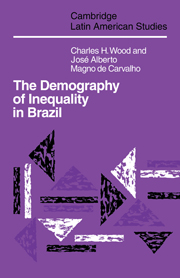Book contents
- Frontmatter
- Contents
- Illustrations
- List of tables
- Preface
- 1 Introduction
- 2 Framework for the study of population, development and inequality
- 3 Growth and distribution in historical perspective
- 4 Income inequality and length of life
- 5 Wage policy, infant mortality and collective social action in São Paulo
- 6 Racial inequality and child mortality
- 7 The “baby bust”
- 8 Income distribution and population growth
- 9 Agrarian structure and the rural exodus
- 10 Colonization and frontier expansion in Amazônia
- 11 Development and persistent underemployment
- 12 The demography of inequality in Brazil: summary and conclusion
- Appendix: A note on method
- Notes
- Bibliography
- Index
- CAMBRIDGE LATIN AMERICAN STUDIES
9 - Agrarian structure and the rural exodus
Published online by Cambridge University Press: 04 August 2010
- Frontmatter
- Contents
- Illustrations
- List of tables
- Preface
- 1 Introduction
- 2 Framework for the study of population, development and inequality
- 3 Growth and distribution in historical perspective
- 4 Income inequality and length of life
- 5 Wage policy, infant mortality and collective social action in São Paulo
- 6 Racial inequality and child mortality
- 7 The “baby bust”
- 8 Income distribution and population growth
- 9 Agrarian structure and the rural exodus
- 10 Colonization and frontier expansion in Amazônia
- 11 Development and persistent underemployment
- 12 The demography of inequality in Brazil: summary and conclusion
- Appendix: A note on method
- Notes
- Bibliography
- Index
- CAMBRIDGE LATIN AMERICAN STUDIES
Summary
Only a few years ago, when the modernization perspective dominated the development literature, rural-to-urban migration was viewed as a positive aspect of structural change. W. Arthur Lewis's influential two-sector model was premised on the idea that the marginal productivity of labor in the countryside was zero. Economic growth meant the withdrawal of labor from agriculture and its incorporation into the urban industrial sector. For economists who stressed the benefits of labor transfer, the concern was how to increase the urbanward flow. Indeed, as Richard Jolly (cited in Todaro 1981:231), director of the Institute of Development Studies at the University of Sussex noted, “one of the reasons given for trying to increase productivity in the agricultural sector was to release sufficient labor for urban industrialization. How irrelevant most of this concern looks today!”
In contrast to the earlier view, contemporary perspectives see rural out-migration in a very different light. Today, urbanward migration is no longer seen as a beneficent process necessary to solve the problems of growing urban labor demand but, instead, as a major factor contributing to urban surplus labor. The effect of internal migration, in Todaro's (1981: 231) view, is to exacerbate rural-urban structural imbalances in two ways. On the supply side, the rural exodus disproportionately increases the growth rate of urban job seekers relative to urban population growth.
- Type
- Chapter
- Information
- The Demography of Inequality in Brazil , pp. 201 - 220Publisher: Cambridge University PressPrint publication year: 1988



